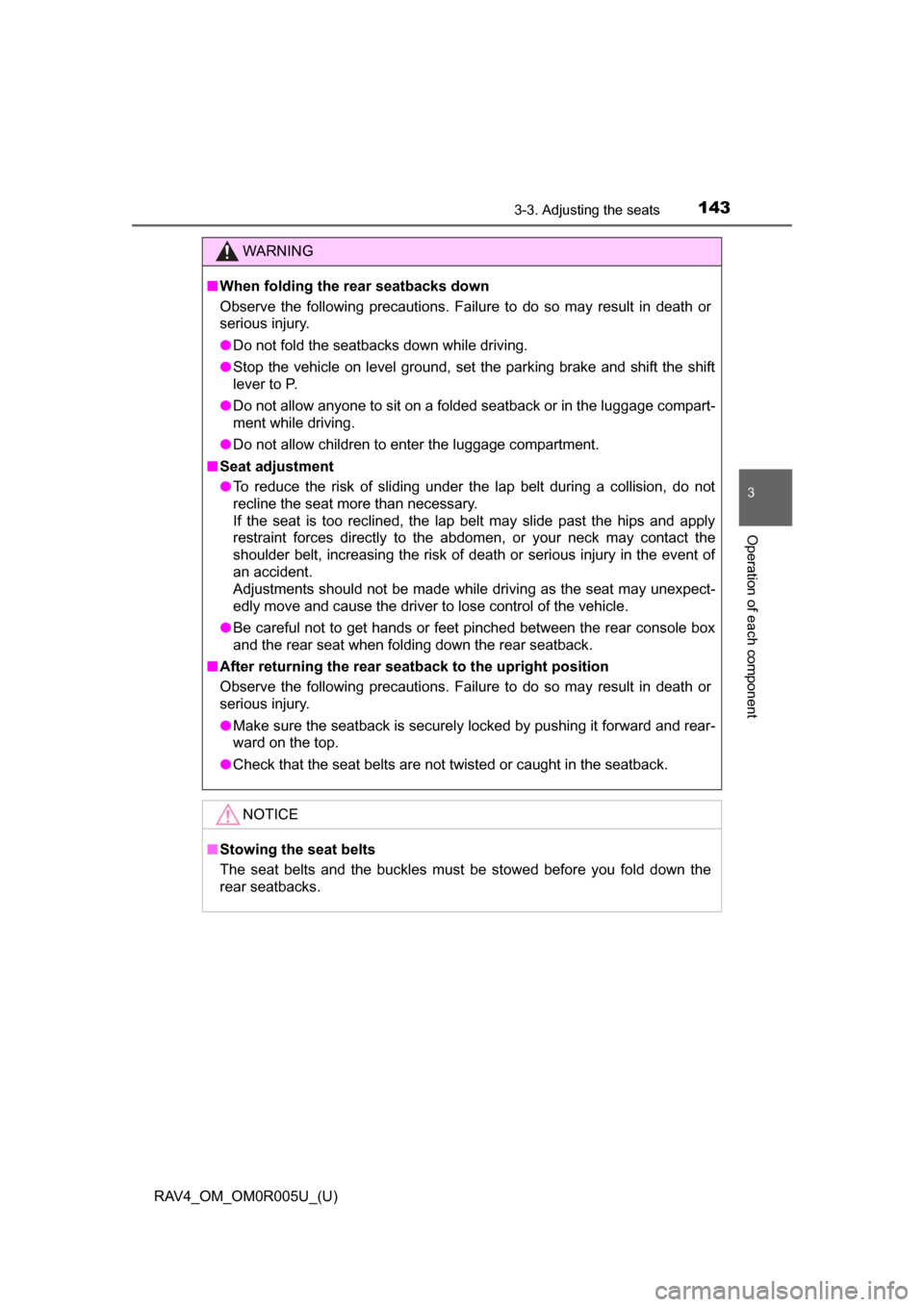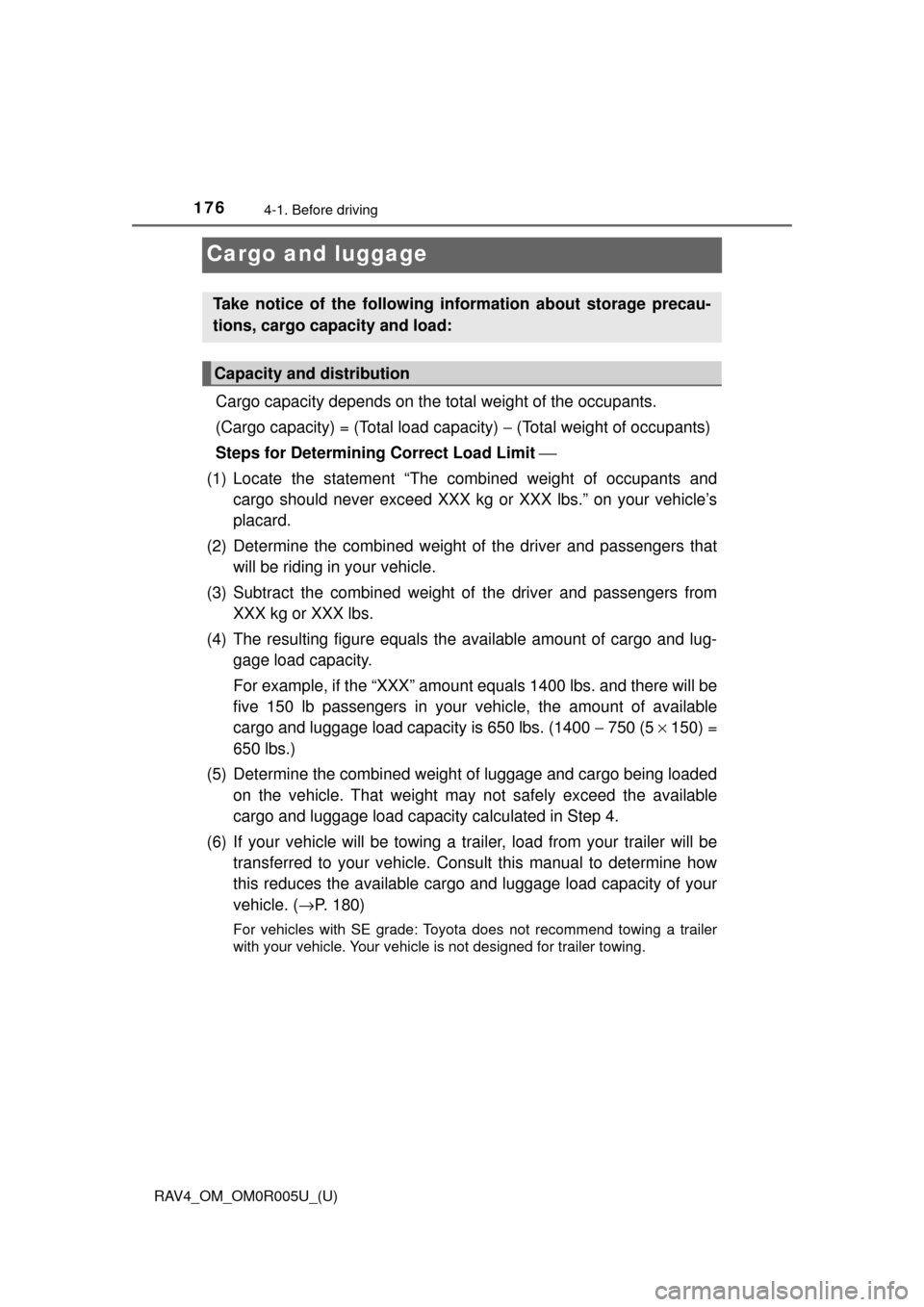Page 122 of 741

122
RAV4_OM_OM0R005U_(U)
3-2. Opening, closing and locking the doors
■Situations in which the touchless sensor does not operate properly
(vehicles with touc hless power back door)
If the touchless sensor does not operate in the following situations, use the
back door opener switch or power back door switch or wireless remote con-
trol to open the power back door. ( →P. 114)
● When the rear bumper is subjected to strong impact
● When an external radio wave source interferes with the communication
between the vehicle and electronic key ( →P. 111 )
● When a large amount of water is kept applying to the lower center part of the
rear bumper, such as in heavy rain
● When the vehicle is being washed and water is kept applying to lower center
part of the rear bumper
● When the lower center part of the rear bumper is covered with mud, snow,
ice, etc.
● When a metal object, etc., such as a towing hitch is installed near the lower
center part of the rear bumper
● When the vehicle has been parked for a while near objects that may move
and contact the lower center part of the rear bumper, such as grass or trees
● When the vehicle is parked at an area where an electric field is generated,
such as a road with an electric snow melting system or parking meters
■ Customization (vehicles with power back door)
Settings (e.g. power back door opening angle) can be changed.
(Customizable features: →P. 697)
Page 132 of 741

132
RAV4_OM_OM0R005U_(U)
3-2. Opening, closing and locking the doors
■Conditions affecting operation
The smart key system uses weak radio waves. In the following situations, the
communication between the electronic key and the vehicle may be affected,
preventing the smart key system, wireless remote control and engine immobi-
lizer system from operating properly. (Ways of coping: →P. 656)
● When the electronic key battery is depleted
● Near a TV tower, electric power plant, gas station, radio station, large dis-
play, airport or other facility that generates strong radio waves or electrical
noise
● When carrying a portable radio, cellular phone, cordless phone or other
wireless communication device
● When the electronic key is in contact with, or is covered by the following
metallic objects
• Cards to which aluminum foil is attached
• Cigarette boxes that have aluminum foil inside
• Metallic wallets or bags
• Coins
• Hand warmers made of metal
• Media such as CDs and DVDs
● When other wireless keys (that emit radio waves) are being used nearby
● When carrying the electronic key together with the following devices that
emit radio waves
• Another vehicle’s electronic key or a wireless key that emits radio waves
• Personal computers or personal digital assistants (PDAs)
• Digital audio players
• Portable game systems
● If window tint with a metallic content or metallic objects are attached to the
rear window
● When the electronic key is placed near a battery charger or electronic
devices
Page 142 of 741
142
RAV4_OM_OM0R005U_(U)
3-3. Adjusting the seats
■Before folding down the rear seatbacksStow the rear center seat belt. ( →P. 3 0 )
Stow the rear seat belt buck-
les.
Lower the head restraint to the lowest position. (→P. 146)
■Folding down rear seatbacks
Pull the seatback angle adjust-
ment lever and fold down the
seatback.
Folding down the rear seatbacks
1
2
3
Page 143 of 741

RAV4_OM_OM0R005U_(U)
1433-3. Adjusting the seats
3
Operation of each component
WARNING
■When folding the rear seatbacks down
Observe the following precautions. Failure to do so may result in death or
serious injury.
● Do not fold the seatbacks down while driving.
● Stop the vehicle on level ground, set the parking brake and shift the shift
lever to P.
● Do not allow anyone to sit on a folded seatback or in the luggage compart-
ment while driving.
● Do not allow children to enter the luggage compartment.
■ Seat adjustment
● To reduce the risk of sliding under the lap belt during a collision, do not
recline the seat more than necessary.
If the seat is too reclined, the lap belt may slide past the hips and apply
restraint forces directly to the abdomen, or your neck may contact the
shoulder belt, increasing the risk of death or serious injury in the event of
an accident.
Adjustments should not be made while driving as the seat may unexpect-
edly move and cause the driver to lose control of the vehicle.
● Be careful not to get hands or feet pinched between the rear console box\
and the rear seat when folding down the rear seatback.
■ After returning the rear seatback to the upright position
Observe the following precautions. Failure to do so may result in death or
serious injury.
● Make sure the seatback is securely locked by pushing it forward and rear-
ward on the top.
● Check that the seat belts are not twisted or caught in the seatback.
NOTICE
■ Stowing the seat belts
The seat belts and the buckles must be stowed before you fold down the
rear seatbacks.
Page 148 of 741
148
RAV4_OM_OM0R005U_(U)
3-3. Adjusting the seats
■Adjusting the height of the head restraints
■ Adjusting the rear center seat head restraint
Always raise the head restraint one level from the stowed position when
using. Make sure that the head restraints are
adjusted so that the center of the head
restraint is closest to the top of your ears.
WARNING
■ Head restraint precautions
Observe the following precautions regarding the head restraints. Failure to
do so may result in death or serious injury.
● Use the head restraints designed for each respective seat.
● Adjust the head restraints to the correct position at all times.
● After adjusting the head restraints, push down on them and make sure
they are locked in position.
● Do not drive with the head restraints removed.
Page 165 of 741

165
RAV4_OM_OM0R005U_(U)
4Driving
4-1. Before drivingDriving the vehicle ............. 166
Cargo and luggage ........... 176
Vehicle load limits ............. 180
Trailer towing..................... 181
Dinghy towing ................... 195
4-2. Driving procedures Engine (ignition) switch (vehicles without
smart key system) ........... 196
Engine (ignition) switch (vehicles with
smart key system) ........... 198
Automatic transmission ..... 203
Turn signal lever................ 211
Parking brake .................... 212
4-3. Operating the lights and wipers
Headlight switch ................ 213
Automatic High Beam ....... 217
Fog light switch ................. 221
Windshield wipers and washer ..................... 222
Rear window wiper and washer ..................... 226 4-4. Refueling
Opening the fuel tank cap .................................. 229
4-5. Using the driving support systems
Toyota Safety Sense P ..... 232
PCS (Pre-Collision System) .... 239
LDA (Lane Departure Alert with steering
control) ............................ 253
Dynamic radar cruise control ............................. 261
Cruise control .................... 273
Intuitive parking assist....... 277
Rear view monitor system ............................ 286
All-wheel drive lock switch (AWD models) ..... 296
BSM (Blind Spot Monitor) ........ 297
• The Blind Spot Monitor function ......................... 301
• The Rear Cross Traffic Alert function ................. 304
Driving assist systems ...... 307
4-6. Driving tips Winter driving tips ............. 314
Utility vehicle precautions ..................... 318
Page 167 of 741

RAV4_OM_OM0R005U_(U)
1674-1. Before driving
4
Driving
Make sure that the parking brake is set and shift the shift lever to D.
Gently depress the accelerator pedal.
Release the parking brake.
■When starting off on a uphill
The hill-start assist control will activate. ( →P. 307)
■ Driving in the rain
●Drive carefully when it is raining, because visibility will be reduced, the win-
dows may become fogged-up, and the road will be slippery.
● Drive carefully when it starts to rain, because the road surface will be espe-
cially slippery.
● Refrain from high speeds when driving on an expressway in the rain,
because there may be a layer of water between the tires and the road sur-
face, preventing the steering and brakes from operating properly.
■ Engine speed while driving
In the following conditions, the engine speed may become high while driving.
This is due to automatic up-shifting control or down-shifting implementation to
meet driving conditions. It does not indicate sudden acceleration.
●The vehicle is judged to be driving uphill or downhill
● When the accelerator pedal is released
● When the brake pedal is depressed while sport mode is selected
■ Breaking in your new Toyota
To extend the life of the vehicle, observing the following precautions is recom-
mended:
●For the first 200 miles (300 km):
Avoid sudden stops.
● For the first 500 miles (800 km):
Do not tow a trailer.
● For the first 600 miles (1000 km):
• Do not drive at extremely high speed.
• Avoid sudden acceleration.
• Do not drive continuously in low gears.
• Do not drive at a constant speed for extended periods.
Starting off on a steep uphill
1
2
3
Page 176 of 741

176
RAV4_OM_OM0R005U_(U)
4-1. Before driving
Cargo and luggage
Cargo capacity depends on the total weight of the occupants.
(Cargo capacity) = (Total load capacity) − (Total weight of occupants)
Steps for Determining Correct Load Limit ⎯
(1) Locate the statement “The comb ined weight of occupants and
cargo should never exceed XXX kg or XXX lbs.” on your vehicle’s
placard.
(2) Determine the combined weight of the driver and passengers that
will be riding in your vehicle.
(3) Subtract the combined weight of the driver and passengers from
XXX kg or XXX lbs.
(4) The resulting figure equals the available amount of cargo and lug- gage load capacity.
For example, if the “ XXX” amount equals 1400 lbs. and there will be
five 150 lb passengers in your v ehicle, the amount of available
cargo and luggage load capacity is 650 lbs. (1400 − 750 (5 × 150) =
650 lbs.)
(5) Determine the combined weight of luggage and cargo being loaded on the vehicle. That weight ma y not safely exceed the available
cargo and luggage load capacity calculated in Step 4.
(6) If your vehicle will be towing a tr ailer, load from your trailer will be
transferred to your vehicle. Consult this manual to determine how
this reduces the available cargo and luggage load capacity of your
vehicle. ( →P. 180)
For vehicles with SE grade: Toyota does not recommend towing a trailer
with your vehicle. Your vehicle is not designed for trailer towing.
Take notice of the following information about storage precau-
tions, cargo capacity and load:
Capacity and distribution